
Hitler might have won World War Two. It was a very close run thing.
However, he put too much faith in a machine for encrypting messages. It was the Enigma machine. It wasn't unreasonable to put a great deal of faith in it. Fortunately, the operators of the machines made mistakes and a team of brilliant minds, mostly at Bletchley Park, found a way to decrypt messages they were not supposed to read.
I have had a lot of fun over decades learning about the Enigma machine, and I hope this essay will be interesting to you, and help you understand some things about the Enigma machine.
I hope that even young readers will be able follow and enjoy the story.
I hope it is easy reading, in the beginning. Don't worry. It gets harder once it gets going.
This essay will "only" discuss how the Enigma machine worked. But fully understanding that will be a big help to you if ever you try to understand how the Bletchley Park people... Turing, Welchman, others... managed to decrypt the German messages. It is an epic story, and worthy of your effort.
If this page amuses you, and you are a programmer, you might also be amused by my page about how you might create an Enigma simulator.
If you had to operate the Enigma machine, you would need very little training.
And one of the beautiful things about the Enigma machine is that if you know how to encrypt a message with one, you know how to decrypt a message with one. One machine, and one process is capable of both jobs!
And it is, on some levels, a very simple machine. Just a box perhaps a foot wide, 14 inches deep and 8 inches high when closed up for storage. .
It was mostly a mechanical, gear driven device... but it also had an electrical side... a battery was needed to turn light bulbs on. (We'd use LEDs today.) (Image from Wikipedia)
First the operator "set" the machine to the right "key" for the message concerned. If you didn't know the key, it would be very, very difficult for you to decrypt a mesage encrypted with it.
I'll discuss the settings and the keys later. We don't need the details here.
I will tell you here, now, that I am going to use the word "button" where "key" might be used normally. I'm using the word "button" so that there can be no confusion with the "key", as used in the past few paragraphs.
When you opened the Enigma to use it, two things were particularly obvious. It had 26 things which looked a lot like typewriter-"keys". (That word again".) I'm going to call these the Enigma machine's "buttons". The operator had to press them, the same way you press the.... things!... on a typwriter or computer keyboard.
Each button had a letter of the alphabet on it.
By the way... the letters of the alphabet were the ONLY thing the Enigma machine could handle. Numbers had to be written out, e.g. "six" instead of "6".
Therewerentevenanyspacesorapostrophes.
ANDONLYUPPERCASELETTERSWEREAVAILABLE.
"(There weren't even any spaces or apostrophes. And only UPPER CASE letters were available.)
Press the button for each letter in the message in turn.
Each time a button was pressed, a light bulb would come on.
There were 26 light bulbs. They were under 256 small glass windows. Each window had one letter of the alphabet painted in it.
So... let's say that when the operator pressed the "M" button, the "Y" would light up. Or when the operator pressed the "B" button, the "E" lit up. Etc.
The operator pressed the buttons for the letters in the message he/ she was encrypting or decrypting, and wrote down which letter lit up as a result of each button press. What the operator wrote down was the encrypted message, or the decrypted message, depending on what sort of message was begin processed.
Well... simple to do! And simple is, of course, good. The Enigma was a very good machine in many ways.
There's a quirk of the Enigma machine that you should know about. Because of its design, no matter what key you pressed, you never say the same letter light up. (I.e., if you pressed, say, "G", it wouldn't be the "G" bulb which came one.
And there's a feature you should be aware of...
The letter which lit up the second time you pressed any particular button would almost always be a different letter than the one that lit up the last time you pressed that button!
(Don't worry about why I mentioned those things. But you may find knowing them helpful.)
If you aren't comfortable that using an Enigma machine was simple, re-read the material above?
But! While USING an Enigma machine might be easy enough (when you knew about putting in the settings), MAKING one was another story...
It starts with something simple, though.
It might not SEEM simple at first, but... trust me? And bear with my diagram below. It will look odd for now, but the reason for the oddness will become clear later.
Please don't be alarmed by the upcoming diagram. There are notes to help you with it, underneath it.
The machine was, on one level, "just" the following 13 times over. The circuit below has two buttons, two light bulbs to glow under a letter. The buttons happen to be for "M" and "G", and the bulbs are for the same letters... but note that the "M" button is near the "G" bulb, and vice versa.
If you repeated it 13 times, you'd have all the buttons and light bulbs you'd need, right? (How this will be any use to encrypting text will not be clear just yet. Don't worry about that now.)
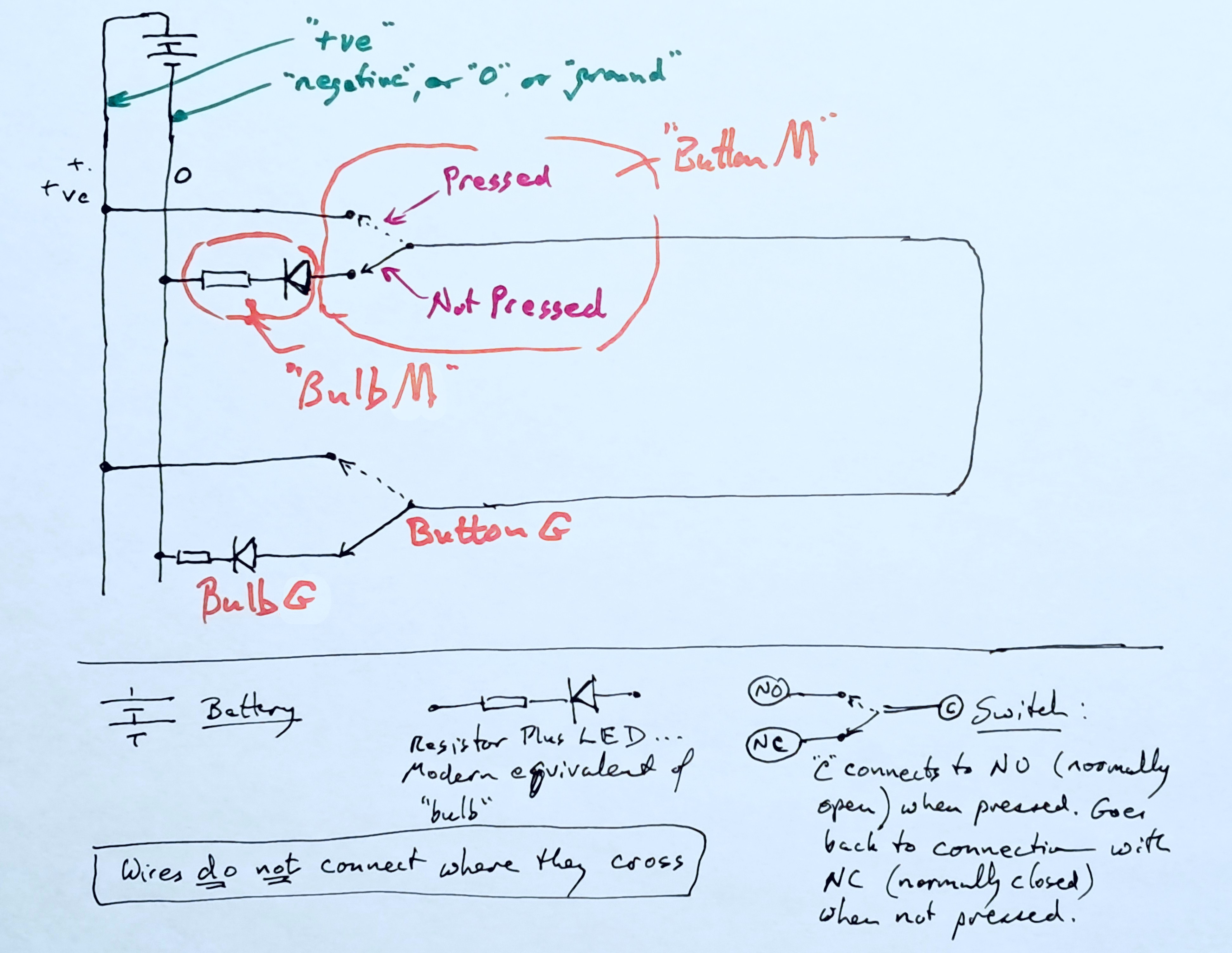
The diagram above is with neither button pressed. With no button pressed, there are no circuits to cause either bulb to light.
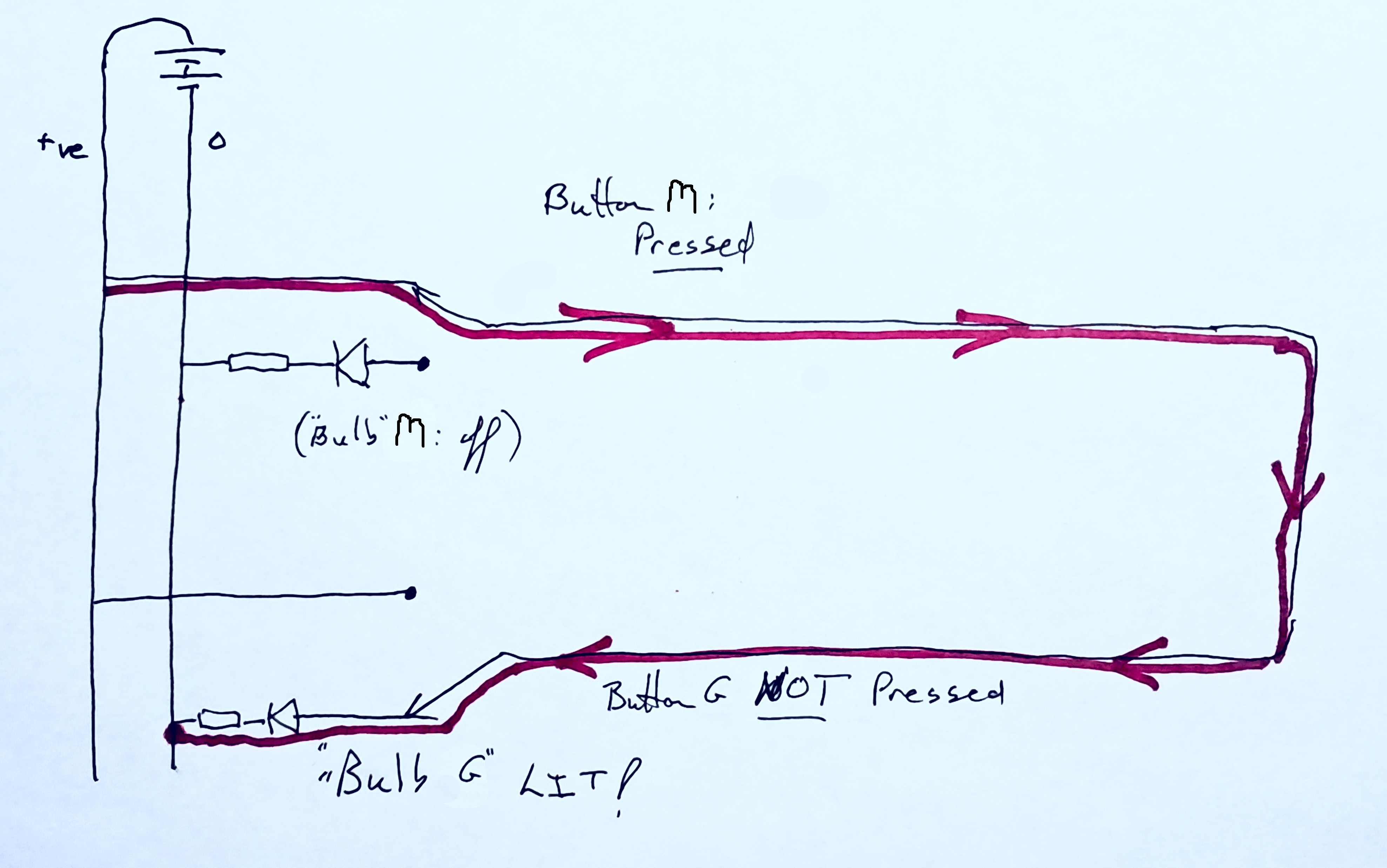
The diagram above is with button "M" pressed. There is now a path for a current to flow:
-- from the battery's positive terminal ("+ve")
-- through bulb "G"
-- and onward to the battery's other end ("0" (volts))...
AND SO, bulb "G" lights up when button "M" is pressed! (^_^)
But it gets better!....
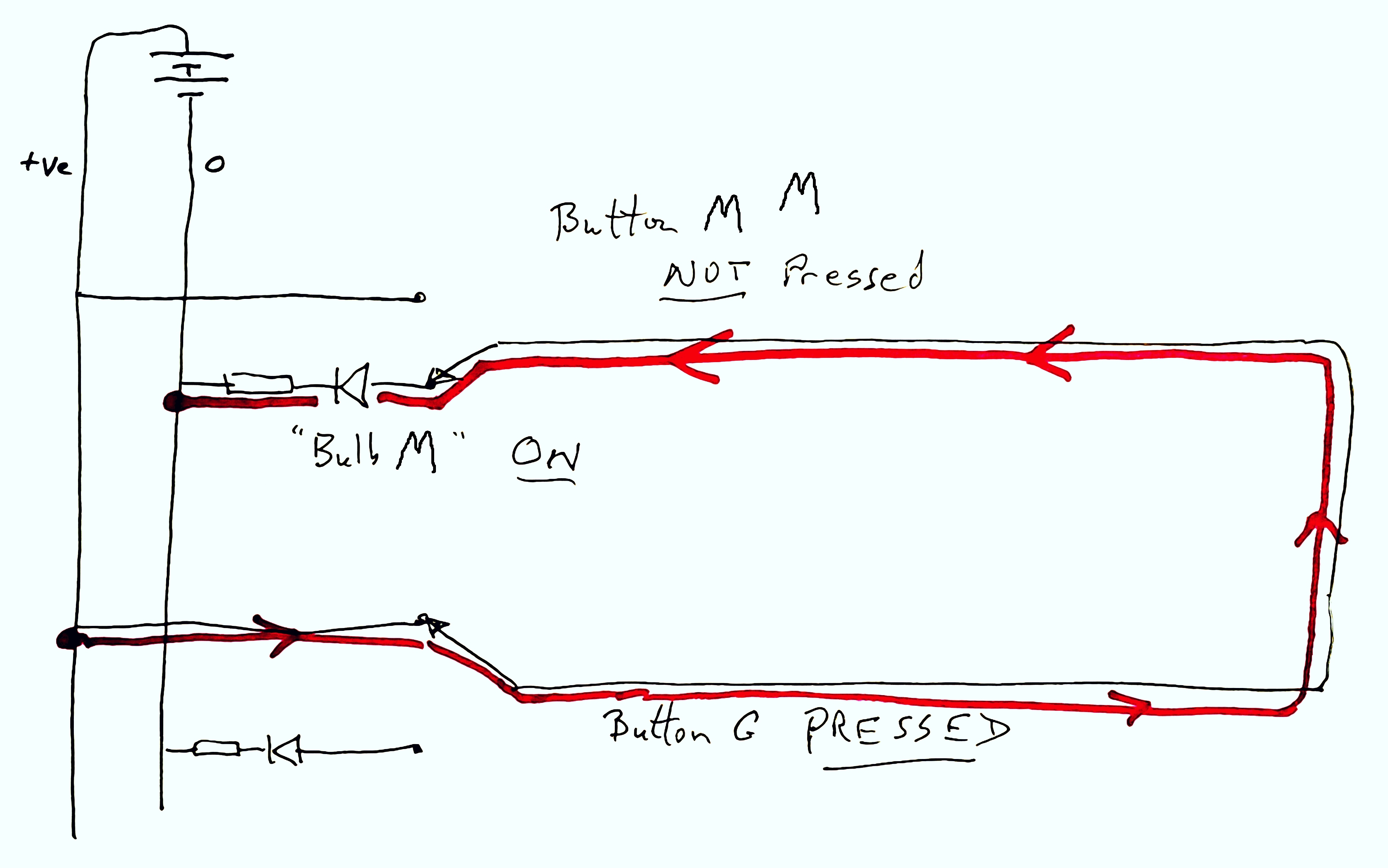
The diagram above shows what happens when button "G" is pressed.
Now there is a circuit from the battery's positive terminal ("+ve"), through bulb "M", and onward to the battery's other ("0" (volts)), so now bulb "M" lights up.
Okay? Review all the stuff from "It starts with something simple, though." if not. I suspect there are some questions in your mind. Don't worry too much about them just yet, as long as you are clear that *if* we had the circuit above, and pressed buttons as suggested, we'd see the "bulbs" (or LEDs) light up as described.
(Oh- and remember that each bulb under a glass window with the bulb's letter painted on it... or some modern equivalent arrangement.)
It is a little weird. Not complicated. Doesn't cause problems. But in the circuit shown, sometimes the current flows one way through the wires going to and from the vertical wire at the right hand side of the diagrams... and sometimes it flows the other way!
This isn't something I've seen in many circuits... but it doesn't violate any laws of physics.
An machine that always turns an G into an M, and vice versa... and doesn't encrypt any other letter!... wouldn't be a great deal of use.
Fear not! We're only getting started.
Now consider a "little Enigma" which only encrypts/ decrypts the first six letters of the alphabet.
(What I am about to describe is easily expanded to deal with 26 letters.)
The diagram below is just what we had before, repeated 3 times, with the bulb/ switch part indicated with a simple box.
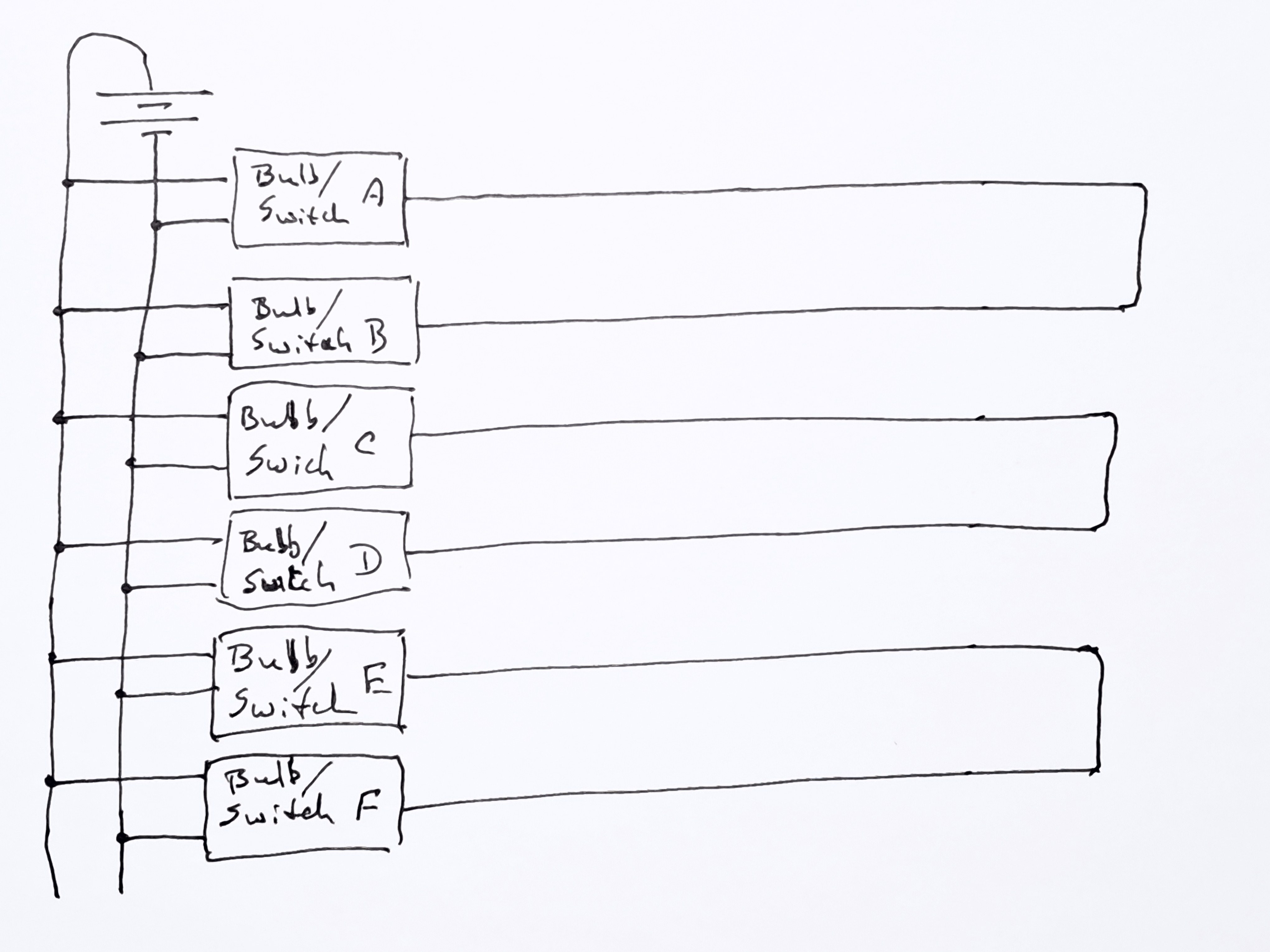
With this we can "encrypt" A as B, and vice versa,
C as D (and vice versa), and
and E as F (and vice versa).
Whoop de do.
Don't lose concentration yet! We are getting there!...
Consider the following... it is, of course, very like what we had before... but just by changing the "loop" connections, our little machine encrypts by different rules!
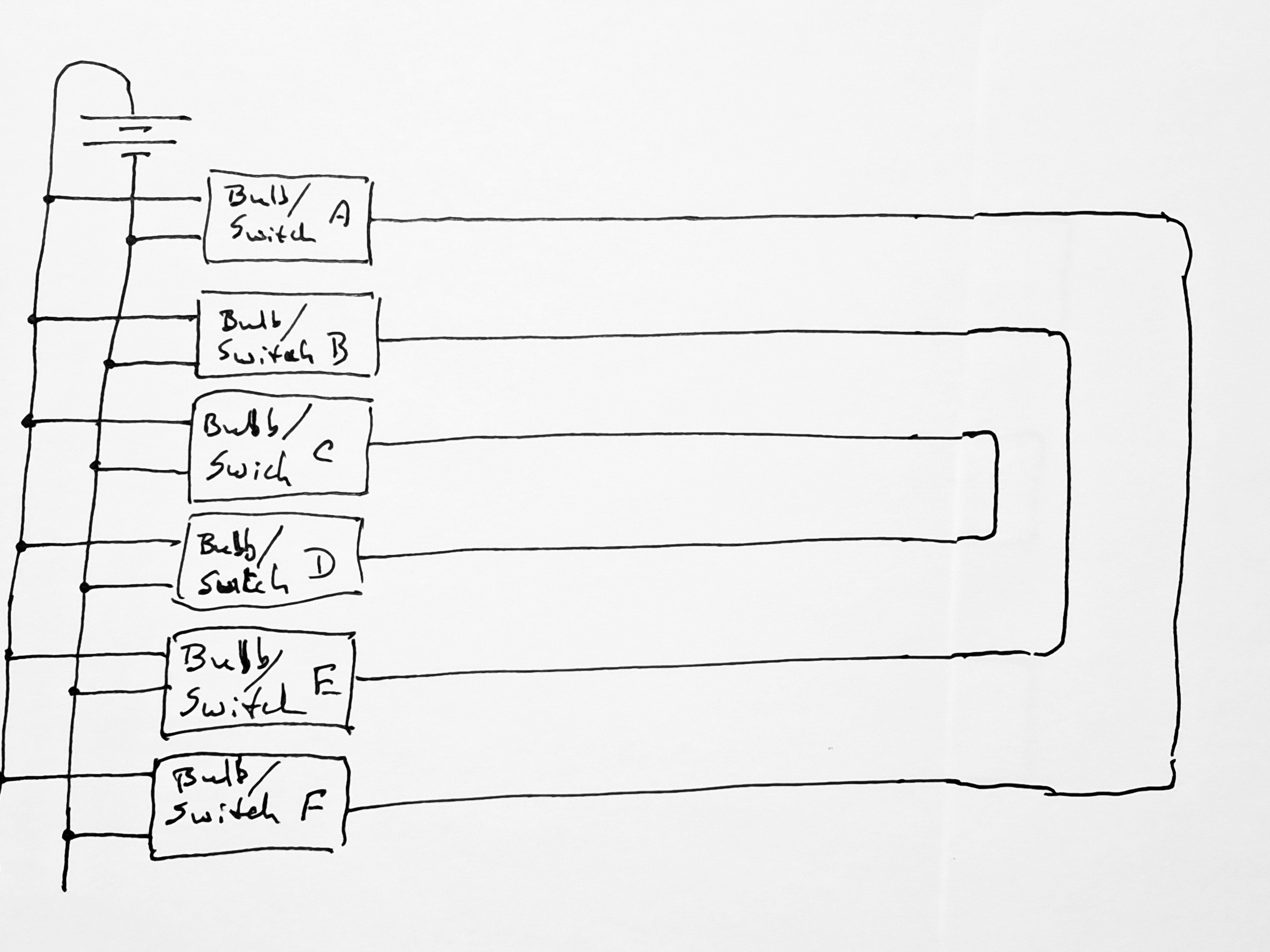
Now we're getting somewhere!
Fasten your seatbelts...
In the Enigma machines used by the Third Reich, the "loops" to the right (in my diagrams) of the button/ lamp modules were NOT the simple affairs we imagined during the build up to the full picture.
Circuits were still completed by a path going out to the right, to the end, turning around, and coming back again. But the path was far from simple!
All of the paths went through a "Stecker Board" twice... once on the way out, once on the way back.
The connections between the two side of the stecker board were easily changed with some cables which were plugged into sockets. More on this another time. Suffice it for now to say that the cables present, and where they were inserted was part of the settings which sender and receiver had to agree, if the system was to work.
The stecker board scrambling was a nuisance, but, as it didn't change over the course of the encryption of a message, it wasn't a great nuisance.
The scrambler was a whole different matter.
The scrambling it introduced changed between every LETTER encrypted!
There were 26 contacts on each side of each wheel. Each contact on one side was connected to one (and only one) contact on the other side.
I haven't attempted to draw the connections between the two sides of each wheel in the following.
After a signal had passed out from the button, and through the steckler, and through the three wheels, the reflector "turned the signal around", and sent it back into "wheel C", to go back, by a different route, to one of the unpressd buttons, and from there to one of the bulbs, and from there to the -ve side of th battery... and the bulb lit up! (^_^)
The "loops" which were so easy to draw previously, were rather tangled in the real world Enigma.
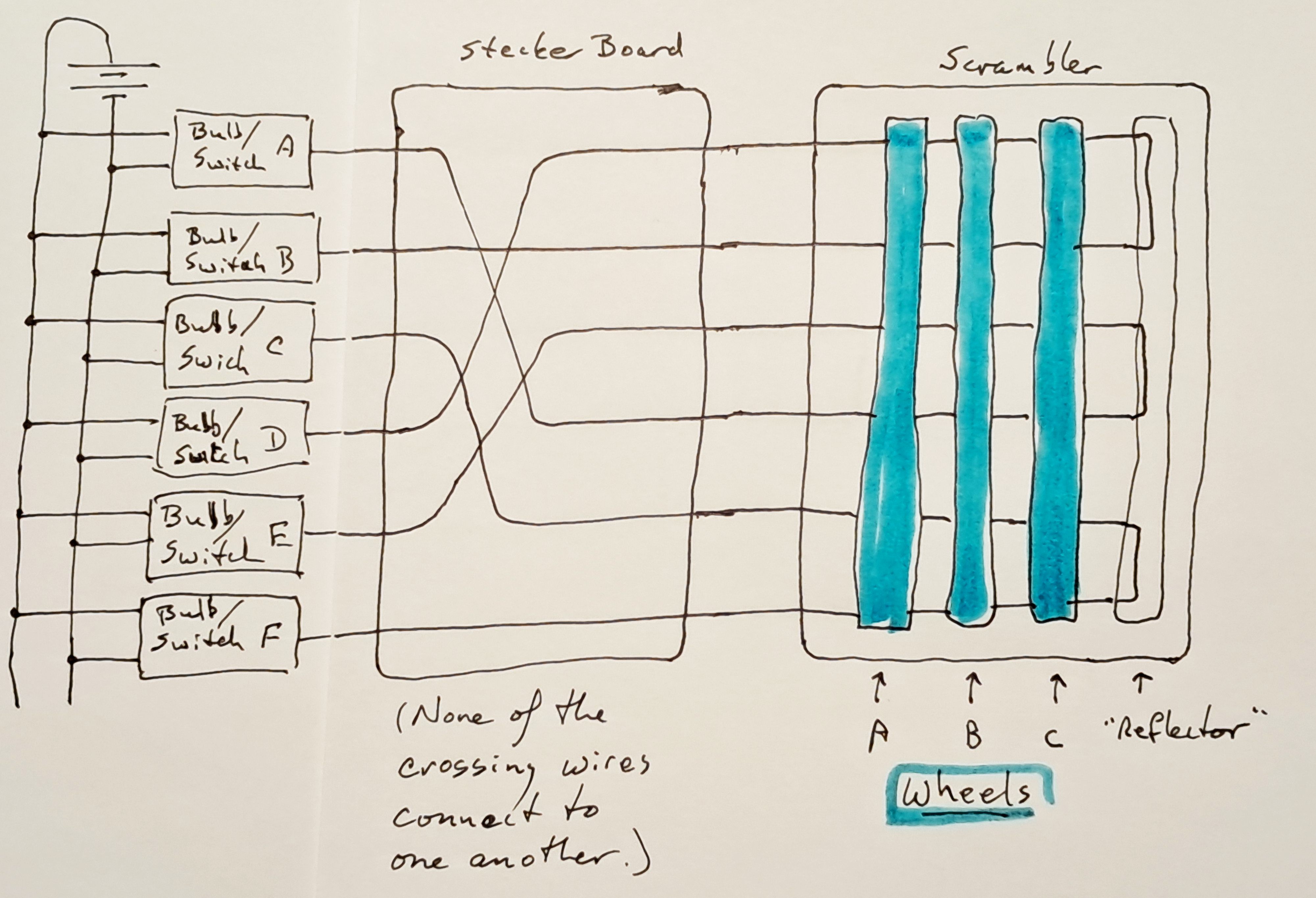
In the following, I HAVE drawn SOME of the connections between the two sides of each of the wheels, and have traced the circuit which would arise if button "B" was pressed.
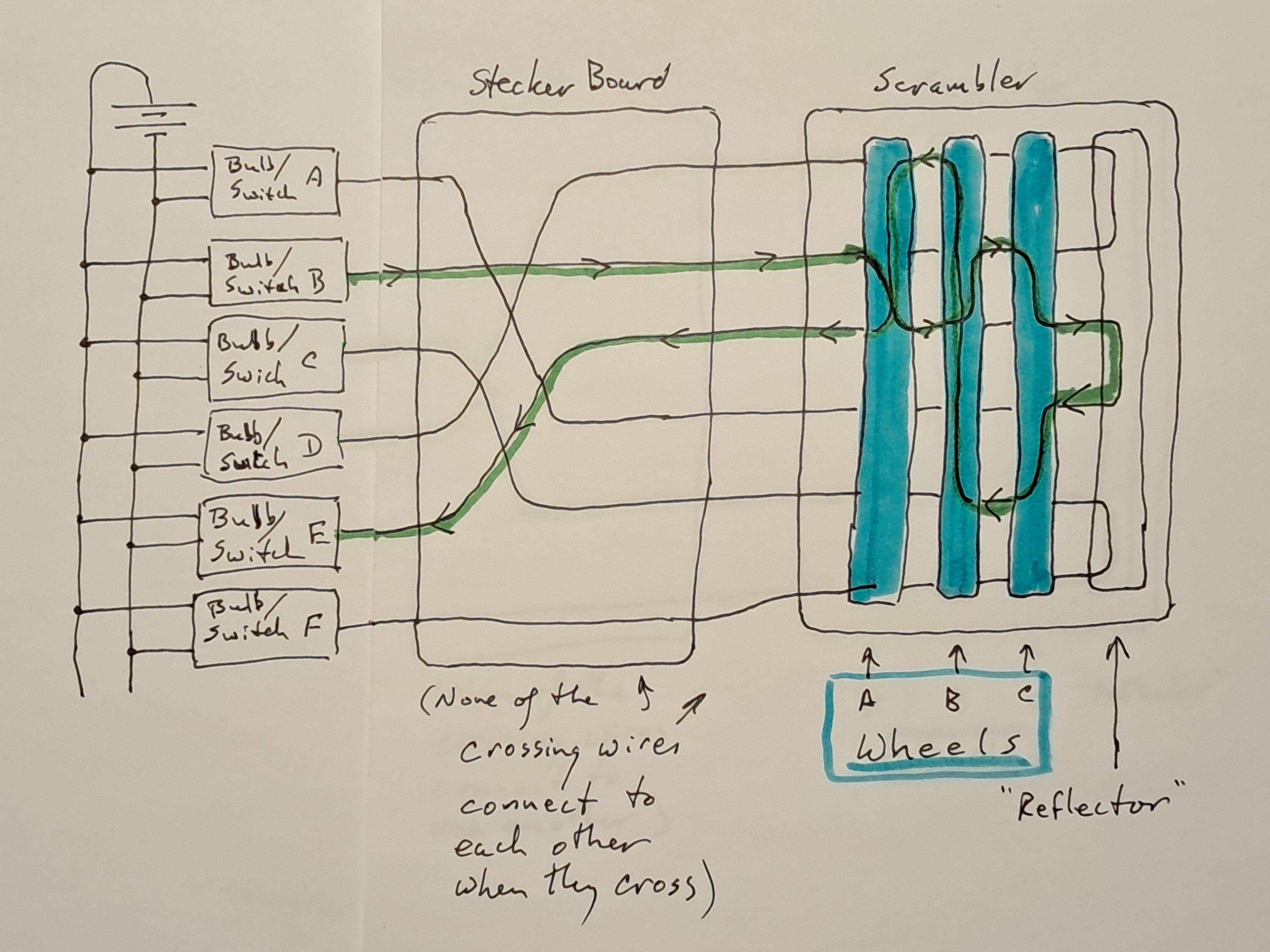
There was a set of 5 wheels, each with different internal wirings. The "setting" specified which wheels were to be used for a particular set of messages, and the order they were to be used in. Which wheels, and the order they were inserted into the machine changed the result when you used the machine.
Simple principles. Quite awesome manufacture. And a brilliant result, from the point of view of people who wanted a secure system for encrypting messages.
Fortunately for us, the people at Bletchley Park were even more brilliant.
They had some unintended help from the Germans. Mistakes were made in how the machine was used. Without them, the messages might not have been decrypted. Happily, the mistakes were made.
Each time the operator pressed a button, one of the wheels rotated by one position... thus changing all of the "pairings" for buttons and bulbs. When 26 letters had been encrypted, the first will changed, as usual, but in addition, the second wheel rotated one position. And yes: When it had made a full revolution, the third wheel advanced by one position.
It was a bit like the odometer in a car, which indicated how many miles it has gone. It starts at 000. After it has gone 9 miles, it says 009. After one more mile, it says 010.
But there was an extra twist with the Enigma wheels. They didn't always cause the next wheel to go forward one when they went past Z.
The letter that caused the next wheel to turn could be different for both of the wheels that made the next one change. And what letter that was could... you guessed it... be changed. What the "change letters" were was another part of the settings which determined what the button/ bulb pairs would be.
And that's "all" there is to it!
There is some very good material at...
https://www.ciphermachinesandcryptology.com/en/enigmatech.htm
If you found this of interest, please mention it in forums, give it a Facebook "like", or whatever. If you want more of this stuff: help!? There's not much point in me writing these things, if no one hears about them. Does anyone feel they are of any use? If YOU do- please spread the word!
Search across several of my sites at once with a Google search button.
Or...

Or...
|
Unlike the clever Google search engine, this one merely looks for the words you type, so....
* Spell them properly.
* Don't bother with "How do I get rich?" That will merely return pages with "how", "do", "I"....
Please also note that I have three other sites, and that this search will not include them. They have their own search buttons.
It's both! Flat-Earth-Academy.com is something I started years ago. For a variety of reasons, I can't offer you httpS:// access there. (As you are not asked to input any information, that's moot, but it "worries" search engines.) So I'm moving to my new, all singing, and will do the httpS:// dance site, "WYWTK.com", and Flat-Earth-Academy is gradually acquiring pages there. (Well, HERE, as what you are reading is one of my "wywtk/fea" pages.)
Why "WYWTK"? It comes from "What You Want To Know".
![]() Page has been tested for compliance with INDUSTRY (not MS-only) standards, using the free, publicly accessible validator at validator.w3.org. It passes in some important ways, but still needs work to fully meet HTML 5 expectations. (If your browser hides your history, you may have to put the page's URL into the validator by hand. Check what page the validator looked at before becoming alarmed by a "not found" or "wrong doctype".)
Page has been tested for compliance with INDUSTRY (not MS-only) standards, using the free, publicly accessible validator at validator.w3.org. It passes in some important ways, but still needs work to fully meet HTML 5 expectations. (If your browser hides your history, you may have to put the page's URL into the validator by hand. Check what page the validator looked at before becoming alarmed by a "not found" or "wrong doctype".)
Why does this page cause a script to run? Because I have my web-traffic monitored for me by eXTReMe tracker. They offer a free tracker. If you want to try one, check out their site. Why do I mention the script? Be sure you know all you need to about spyware.
....... P a g e . . . E n d s .....